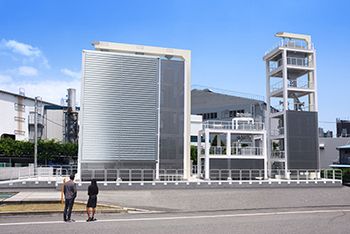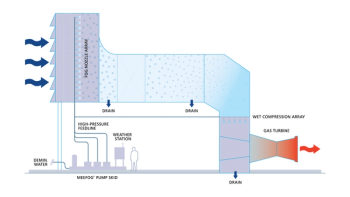
- Handbook 2022
Worldwide Gas Turbine Market Report 2022
The gas turbine sales forecast for the coming decade.
This Forecast International market analysis of gas turbine-powered electrical generation projects that sales over the period 2021-2030 will total $107.705 billion. The prospect of recovery is convincing; however, 2021 might be stagnant with a similar outlook to 2020 due to the lingering COVID-19 pandemic. The dominant response has been to keep most workers home and severely restricted the movements of the rest. Depending on the geographical region, it remains to be seen if further lockdowns will be implemented.
Yet despite COVID-19, it will be a short-term impact only and is already being quickly absorbed. Some countries will differ in their recovery. Therefore, production in Europe, Asia and the Americas might differ slightly. But a medium-term recovery is projected.
In the power generation sector, the initial result was a significant decline, estimated at between 19 and 21% in energy demand as industrial facilities shut down. These developments have led the U.S. Energy Information Administration (EIA) to project that a total of 4.9 GW of previously planned capacity expansions will be delayed into at least 2021 or 2022. Natural gas consumption in the United States decreased in 2020 with some recovery likely in 2021.
Still, it is apparent from both the EIA analysis and our own data (which largely supports the EIA assessment) that the impact of COVID-19 on the power generation equipment industry is surprisingly limited at this time. It is mostly expressed as a delay of projects rather than a dramatic reduction in demand. It is a shallow, short-term dip in the recovery from the much more severe recession that has afflicted the industry since 2014. This situation may change if there are additional waves of the pandemic.
MARKET RECOVERY
The extent of the market collapse over the last six years is remarkable. The estimated size of the market in this year’s market overview is just 48% of the figure recorded in 2014. When Larry Culp became CEO of GE in October 2018, he quoted a similar figure as part of the reason GE had suffered so severely during this period. Siemens’ assessment in 2018 estimated falling sales and industry production overcapacity to be in the same general ballpark.
This sharp fall is a direct result of the spreading crisis caused by overcapacity in the power generation equipment sector and the resulting softness of prices. In short, companies are selling significantly fewer power generation gas turbines than they had predicted and receiving a lower unit price for each sale.
As a direct outcome, all three of the leading companies in the power generation equipment sector – GE, Siemens, and Mitsubishi Power – undertook restructurings to reduce costs and rationalize production. In an inevitable result, these companies announced redundancies. Yet these measures proved of only limited effect; a more fundamental reorganization of the sector appears to be taking place.
General Electric has adopted a different strategy with its former Baker Hughes subsidiary. GE has divested itself from the oil & gas industry whereby Baker Hughes currently supplies gas turbines for compressor drive and power generation for that market. This is evident in that the relatively new LM9000 is marketed solely by Baker Hughes.
The former Mitsubishi Hitachi Power Systems (MHPS) was subject to a different process. It was apparent for some years that the formation of the Mitsubishi-Hitachi joint venture had generated neither the business opportunities nor the technology benefits expected. In addition, the two companies were heading in different directions, with the opportunities for synergistic growth declining quickly. Representatives of Mitsubishi Heavy Industries (MHI) interviewed at trade shows made little effort to hide their disillusionment. In the early months of 2020, MHPS ceased to exist, to be renamed Mitsubishi Power. This has been consolidated further in 2021 into the fold of MHI.
Similarly, Siemens spun off all of gas turbines into Siemens Energy. However, GASTURBINES Like dollar value, unit production of gas turbines worldwide is beginning a slow recovery. But by 2024, sales will have jumped significantly from today’s level. This is projected to peak around 2027 and remain flat at a higher level for the remainder of the decade. unlike GE, the turbines offered seem to cover both the Power Generation and oil & gas industries as mechanical drive machines are still offered.
Often overlooked within the gas turbine market are the Eurasian countries of Ukraine and Russia. In regard to power generation, this is often attributed to a limited area of sale. Currently, Russia generally sells to Russia with Ukraine selling to slightly more customers. Licensed production usually takes the place of physically sending turbines to international operators. There is little information available from United Engine Corp. of Russia and Zorya-Mashproekt of Ukraine. But it seems that within both countries, maintaining machinery with some limited production in the power generation field is the current state of affairs.
From a global perspective, the impact of reduced demand, overcapacity, and soft prices will slowly work itself out of the market. A recovery will take place. Natural gas and renewables will continue to gain ground over the next ten years thus securing the gas turbine’s place in the power market. COVID-19 means this recovery will be later than originally projected, but it will be slightly stronger as delayed projects finally get underway. Once the middle- and far-term periods are reached, the industry will be dominated by large combined-cycle facilities in the industrialized nations, notably Japan and countries in Europe and Asia.
MICROTURBINES
In the period 2021 to 2030, Forecast International is projecting a worldwide unit production of 8,446 microturbine electrical power generation units, a significant increase over earlier projections of about 3,800 units. Value of production is projected to be $779 million.
Reference to 2017 is important, as that was a pivotal year in the microturbine market. The increase in unit production and the decrease in average unit price are attributable to new, very small microturbines currently coming to market. Although they do not add much to the 2021-2030 overall value estimates, their production numbers are significant.
Microturbines have generally grown in power output over the years, and that still holds true. When they started to become a significant market factor in 1999, the average unit on sale had a power output of about 35 kW. Ten years later, this had increased to approximately 100 kW, and it is now approaching 150 kW. There is even a 400 kW stand-alone machine; however, it is not in mass production. There is no indication that the trend of power increases is slowing. There are, however, microturbines going in the other direction.
A trend is developing in Europe toward very small turbine applications. There was a time when microturbines were too powerful for a private residence. But times are slowly changing. MTT’s EnerTwin produces 3.2 kW of electricity and 15.6 kW of thermal power. This puts the machine in a prime position to be utilized in smaller buildings. These new turbines change the forecast significantly. Between 2017’s projection and this current analysis, unit production increases significantly, average unit value decreases significantly, and the total value for the forecast period remains nearly the same.
These new small machines from the likes of MTT and Bladon might change the landscape somewhat, but previous trends still hold true: microturbines have become more powerful, more fuel options are becoming available, and Capstone is still the market leader in terms of value.
Today, microturbines are primarily used for remote power applications in the oil and gas industry and for cooling, heating, and power (CHP) and combined CHP (CCHP) applications in the commercial, industrial, and residential high-rise markets. The success of Bladon’s 12 kW machine would add power in remote locations to the list. An increasing energy demand-supply gap, a rise in the adoption of low-emission power generation sources, and the need to generate power cost-efficiently are some of the factors that will hold microturbines’ place in the market globally.
Articles in this issue
almost 4 years ago
Handbook 2022almost 4 years ago
Integrally geared compression, decarbonization, and emerging markets.almost 4 years ago
Centrifugal pumpsalmost 4 years ago
US Power Industry outlook 2022about 4 years ago
Turbo Tips: How to specify turbomachineryabout 4 years ago
The colors of hydrogen: Why do we care?Newsletter
Power your knowledge with the latest in turbine technology, engineering advances, and energy solutions—subscribe to Turbomachinery International today.





